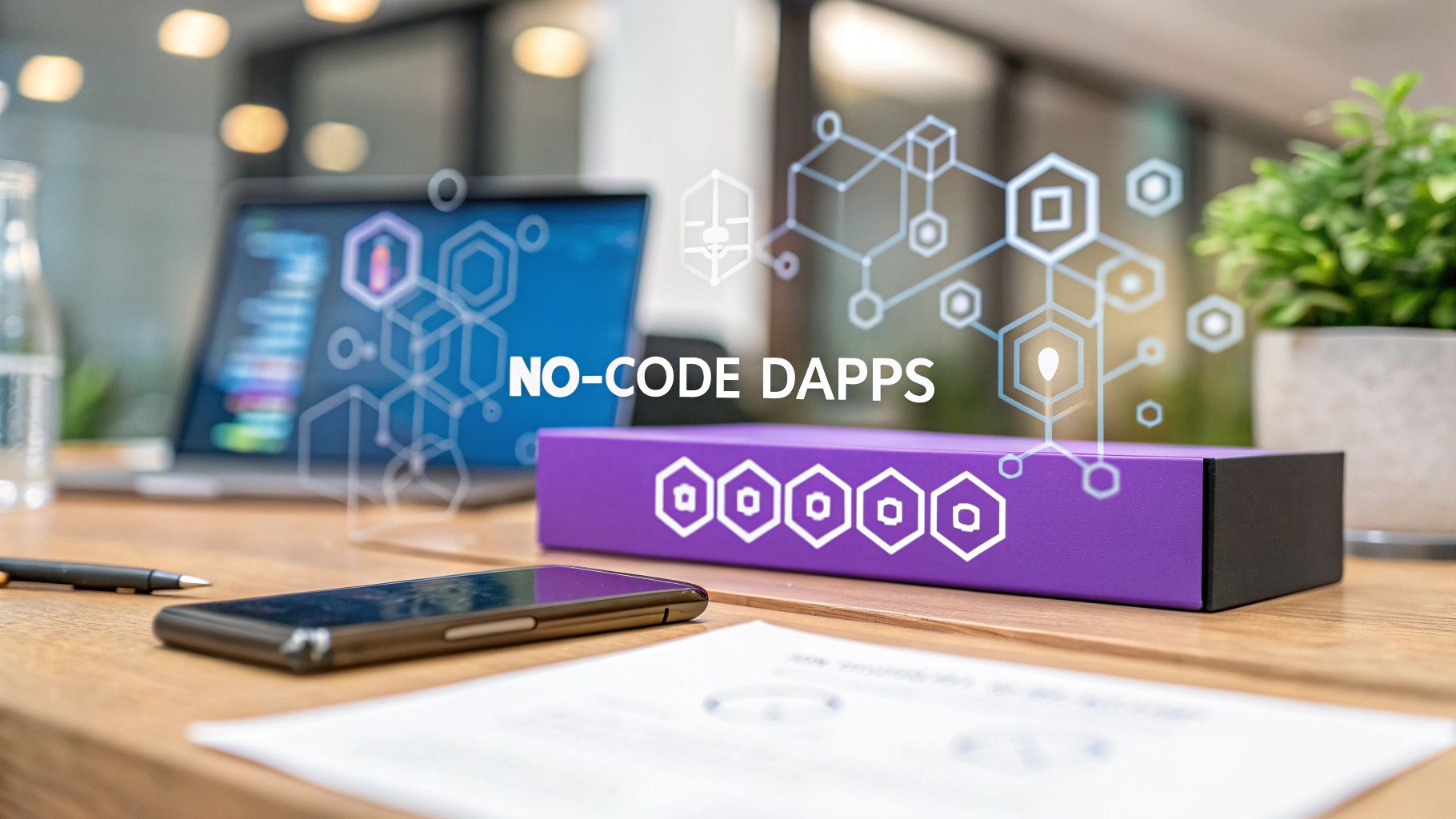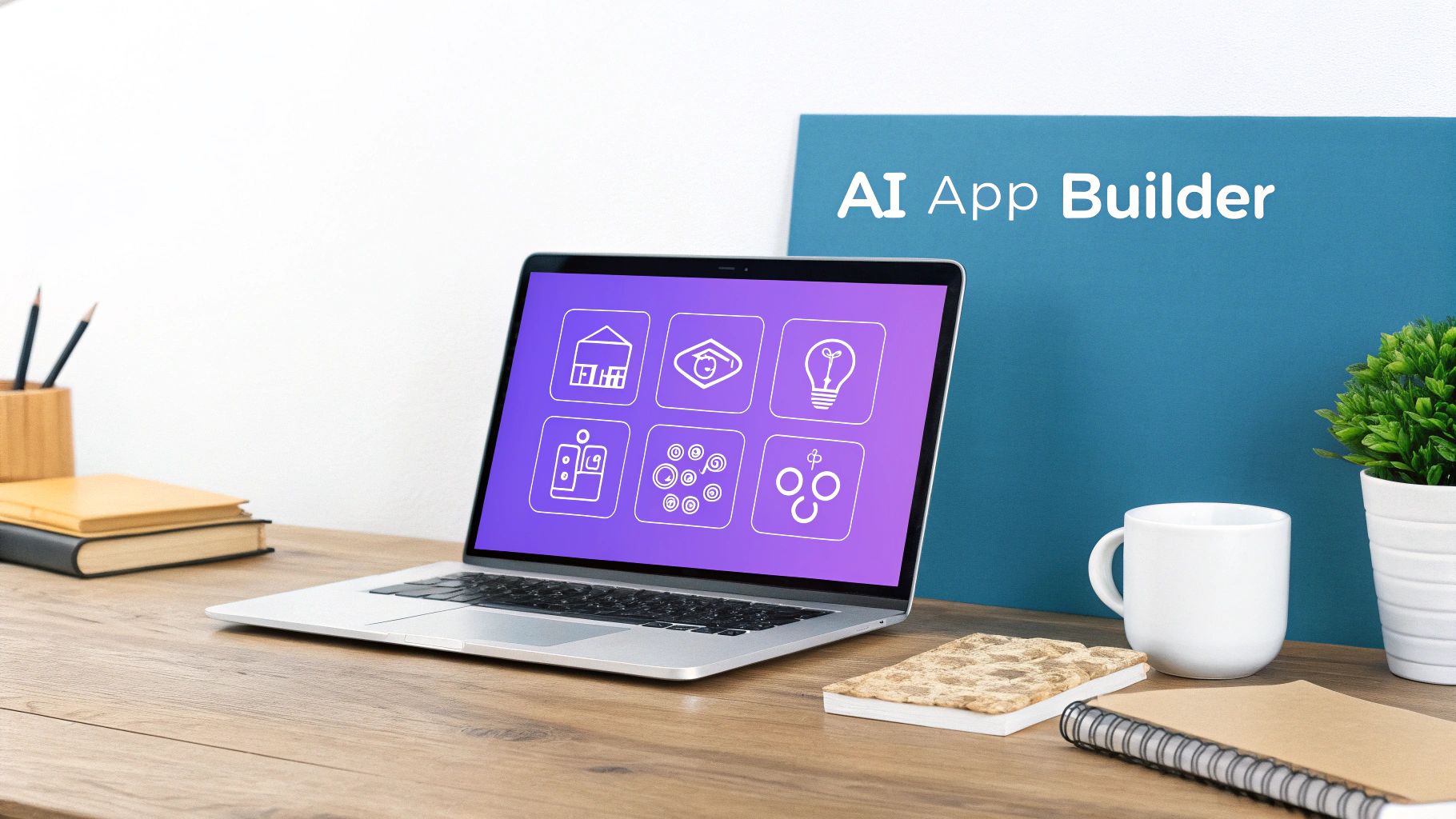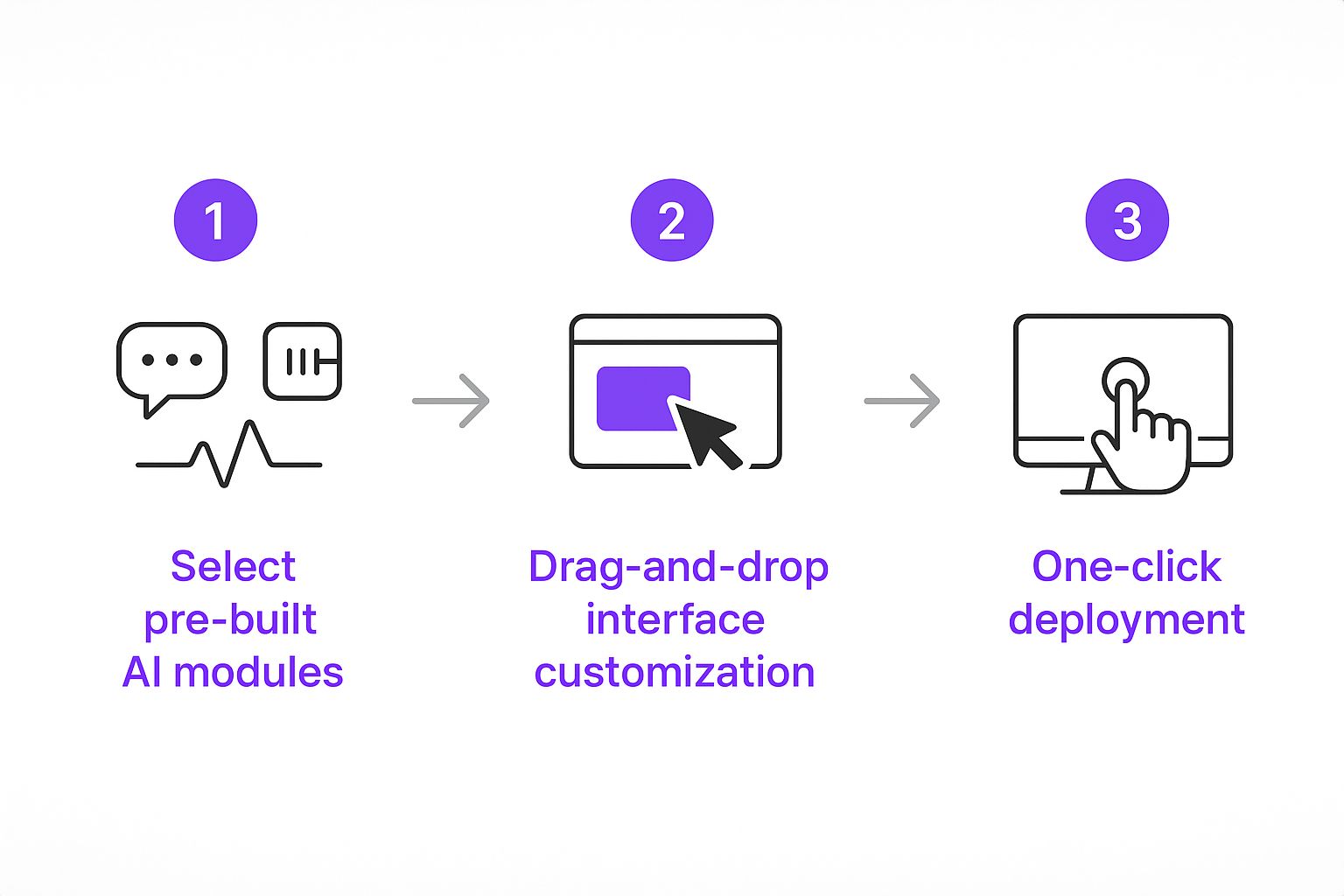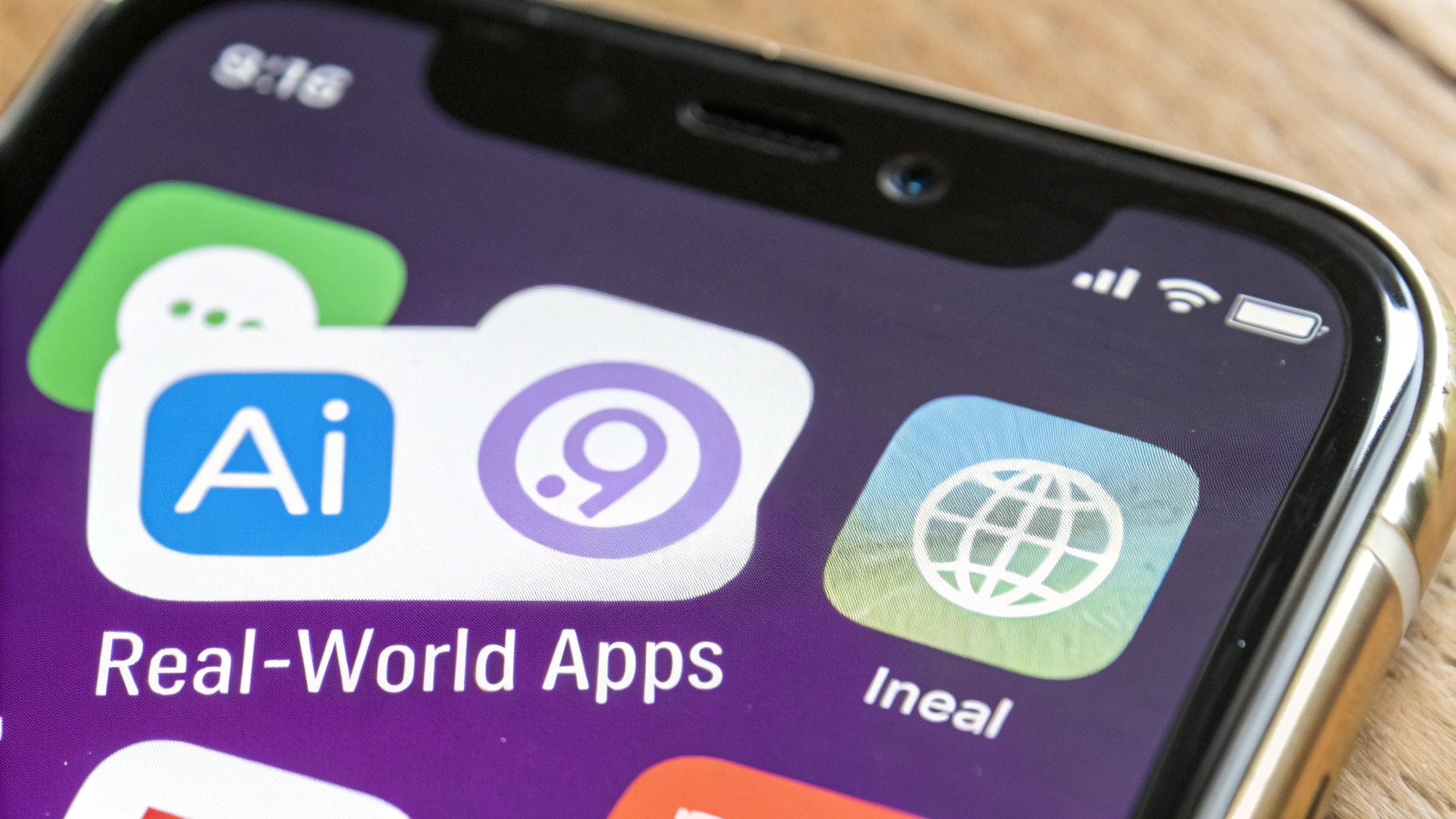Build On-Chain Apps with a No Code AI App Builder

A no-code AI app builder is a platform that lets you create real, working applications with artificial intelligence, all without typing a single line of code. Think of it as having a conversation with a developer. You use visual tools, drag-and-drop elements, and plain English prompts to generate everything from the user interface to the complex logic running in the background.
This whole approach throws the doors wide open, making app development something anyone can do, no matter their technical background.
How No-Code AI Is Flipping On-Chain Development On Its Head

For a long time, building decentralized applications (DApps) on the blockchain felt like a private club. If you didn't speak fluent Solidity or another complex programming language, you weren't getting in. This steep learning curve meant countless brilliant Web3 ideas died on the vine.
Well, that era is coming to a close.
The rise of the no-code AI app builder is completely changing the game for on-chain development. Platforms like the Dreamspace vibe coding studio are tearing down those technical barriers, making it possible for literally anyone to build, test, and ship powerful DApps. You don't have to be a hardcore developer anymore to bring a blockchain project to life.
This shift is empowering a whole new wave of creators:
- Entrepreneurs can now spin up prototypes and launch their Web3 startups at a fraction of the time and cost.
- Artists and creators can build their own NFT marketplaces or token-gated communities without a technical co-founder.
- Businesses can finally start integrating blockchain tech into their operations without needing to hire a specialized (and expensive) development team.
The Real Democratization of Web3 Innovation
At its heart, this technology is all about access. It takes the gnarliest parts of building on-chain—writing secure smart contracts, managing blockchain data, and navigating deployments—and puts them on autopilot. Instead of getting bogged down in code, you get to focus on what actually matters: your idea and the experience you want to create for your users.
And this isn't just a niche trend; it's backed by some serious market momentum. The global low-code market, which no-code is a part of, hit an estimated $28.75 billion and is forecast to rocket to $264.40 billion by 2032. Zooming in, the no-code AI platform market is on a tear, projected to jump from $4.93 billion to $24.42 billion by 2030.
This is about more than just making development easier. It's about unlocking creativity at a scale we've never seen before. When the tools are this simple, the ideas can finally be as complex and ambitious as you want them to be.
For anyone building more sophisticated AI features into their DApp, it's also worth understanding the infrastructure for fueling Generative AI applications with real-time data.
From a Simple Prompt to a Production-Ready App
So, what does this actually look like day-to-day? Imagine just describing your DApp idea in plain English to an AI. With an advanced AI app generator like Dreamspace, that’s exactly where you start.
You can tell it to create smart contracts, generate the right SQL queries to pull data from the blockchain, and even design the website your users will interact with. If you want to dive deeper into the basics, check out our guide on what is no code development.
To get a clearer picture, let's break down the core pieces of the on-chain app we’re about to build.
Starting Your First Project in Dreamspace
Getting started with a new platform can sometimes feel like a chore, but a modern no code AI app builder like the Dreamspace ai app generator makes it surprisingly straightforward. Your journey from a simple idea to a live on-chain app starts with a single, clear instruction. It's less about wrestling with setup wizards and more about clearly explaining your vision to the AI.
After you create an account, you'll land on a clean, uncluttered dashboard. There are no confusing menus to navigate; the focus is squarely on getting you to build something, fast. Right in the center, you’ll find the prompt bar—this is where the real work begins.
Translating Your Idea into an Effective Prompt
The quality of the application the AI generates hinges entirely on the quality of your first prompt. You have to think of it less like a Google search and more like you're writing a project brief for a seasoned developer. If you're vague, you'll get a vague, generic app. But if you're specific and detailed, you’ll get a solid foundation to build upon.
For instance, simply asking to "build a crypto app" won't get you very far. You need to give the AI the what, the where, and the how.
Here are a few examples of prompts that actually work:
- "Build a decentralized voting DApp for community polls on the Polygon network. It should allow token holders to create proposals and vote on them, with voting power proportional to their token holdings."
- "Create a simple NFT minting platform for digital artists on the Base network. The app needs a page to upload an image, add a title and description, and mint it as an ERC-721 token."
- "Generate a smart contract for a token-gated newsletter on Ethereum. Users must hold at least 100 of our custom tokens to access exclusive content, which should be verified on-chain."
See the difference? Each one spells out the core function, the specific blockchain, and the key features. This detail gives the AI the guardrails it needs to generate accurate smart contracts and database structures from the get-go.
Pro Tip: Don't stress about getting the prompt perfect on the first try. This whole process is meant to be iterative. You can always refine, tweak, and add more details with follow-up instructions as the AI builds out the different pieces of your app.
Once you’ve nailed down your initial prompt, you’ll just need to name your project and confirm the blockchain. That’s it. Now you can sit back and let the Dreamspace AI app generator do its thing.
This diagram shows just how simple the high-level workflow is inside a no-code AI builder.

The platform takes all the complex development work and breaks it down into three manageable phases, moving you from your initial idea to a deployed app.
Laying a Solid App Foundation
After a few moments of processing, the Dreamspace vibe coding studio will present you with the initial architecture for your app. This isn't just a mockup—it's the first draft of your smart contract, the database schema needed to index its data, and a basic UI to interact with it. You're looking at a functional skeleton of your application.
This output is your real starting point. From here, you can dig into the AI-generated code, test out the basic functions, and start thinking about where you want to go next.
The most incredible part is that within minutes of signing up, you have a tangible, working foundation for your on-chain app, all from a single sentence written in plain English. This ability to prototype ideas instantly is what makes an AI app generator so powerful. You can validate concepts and build momentum from day one.
Generating Smart Contracts with Simple AI Prompts

This is where your DApp starts to feel real. The core logic of any on-chain application lives in its smart contracts—the self-executing code that dictates every interaction. Historically, this meant sinking months into learning a complex language like Solidity. That steep learning curve has kept countless brilliant ideas on the shelf.
But with a modern no code AI app builder, that entire ordeal gets thrown out the window. Instead of painstakingly writing code, you just describe what you want the contract to do in plain English. The Dreamspace AI app generator translates your instructions into secure, efficient, and deployable smart contract code. It’s a fundamental shift in how blockchain development gets done.
This move toward simplifying software creation is happening everywhere. Gartner predicted that by 2025, a whopping 70% of new applications globally would be built on low-code or no-code platforms. That’s a huge jump from under 25% in 2020 and shows we're moving toward a world where the experts—not just developers—can build their own tools.
Crafting a Prompt for a Real-World Scenario
Let's walk through a practical example. Say you want to build a token-gated community forum. The main rule is simple: only users holding a specific NFT can post messages.
Instead of cracking open a code editor, you'd give the AI a prompt that looks something like this:
"Generate a smart contract for a token-gated community forum on the Polygon network. The contract needs to manage an ERC-721 token that represents a membership pass. Include a function to mint a new token for a specified wallet address, which can only be called by the contract owner. Also, create a function that verifies if a given wallet address owns at least one of these tokens."
That one paragraph gives the AI everything it needs to get started. You've specified the blockchain (Polygon), the token standard (ERC-721), and the core functions for minting and ownership verification. The AI takes this and spits out the initial Solidity code, complete with the right structure and necessary security checks.
The Back-and-Forth of Refining AI Output
The first draft of the contract is rarely the final one. The real magic of using a platform like the Dreamspace vibe coding studio is how you can refine and iterate on the AI's output with simple follow-up prompts. It feels more like a conversation than coding.
Think of it as a collaboration. You’re the strategist, and the AI is your technical executor.
- Adding Complexity: Realize you need to prevent token transfers to keep the community exclusive? A quick follow-up: "Modify the contract to make the ERC-721 tokens non-transferable."
- Enhancing Security: Maybe you want to cap the total number of memberships. Just tell the AI: "Update the minting function to enforce a total supply limit of 1,000 tokens."
- Optimizing for Cost: Gas fees are always a concern. You could ask: "Review the contract for gas optimization opportunities and apply best practices to reduce transaction costs."
This back-and-forth lets you build a sophisticated and robust smart contract without ever having to touch the underlying code. If you're curious about the foundational concepts, we have a detailed guide on how to build smart contracts that goes deeper into the topic.
Under the hood, advanced techniques like Retrieval Augmented Generation (RAG) are often at play. This helps ground the AI's responses in factual, up-to-date information, ensuring the code it generates isn't just syntactically correct but also contextually sound for what you’re building.
By handling the entire process through natural language, a top-tier no code AI app builder takes on the hardest part of blockchain development for you. You get to focus on what your DApp does, while the AI sweats the details of writing secure, efficient code.
Handling Your App's Data Without Ever Writing SQL

A killer DApp isn't just about what happens on-chain. The real magic comes from combining that on-chain logic with rich, off-chain data. We're talking about all the contextual information that makes an app come alive—user profiles, detailed item metadata, transaction histories, you name it.
In the old days, this meant hitting a brick wall. You'd finish your smart contract and then realize you had to become a full-blown backend developer, wrestling with databases and writing mind-numbing SQL queries just to store a username. This is where so many great projects lose steam, buried under the complexity of syncing on-chain events with off-chain databases.
But with a true end-to-end no code AI app builder, that entire headache just vanishes. What was once a massive technical hurdle becomes another simple, conversational step. With Dreamspace's AI app generator, you don't need to know the first thing about database administration to build out a powerful backend.
From Plain English to a Live Database
Forget about manually designing tables or figuring out the right data types. You just tell the AI what you need, the same way you described your smart contract. This completely flips the script on managing your app's data.
Let's stick with our NFT marketplace idea. The smart contract is handling all the minting and transfers, great. But what about the stuff that's too clunky for the blockchain, like artist bios or links to high-res images?
You’d just give the AI a prompt like this:
"Create a user profile table to store a wallet address, username, and sign-up date. I also need another table for NFT metadata that links a token ID to the creator's wallet, a description, and an image URL."
That’s it. The AI instantly translates that into a production-ready database schema. It creates the tables, sets up the right data types (TEXT for a username, TIMESTAMP for the date), and even links them together. The entire backend structure materializes in seconds.
Asking Your Database Questions, Naturally
Getting the data in is only half the story. You also need to get it out and display it in your app. This is where SQL queries usually come in, and they can be a nightmare if you're not a database expert. Well, a top-tier no code AI app builder handles this for you, too.
So, you want to build a gallery showing off all the NFTs minted in the last week. Instead of fumbling with a complex SELECT statement full of JOINs and WHERE clauses, you just ask the AI directly.
- "Write a query to find all users who minted an NFT in the last seven days."
- "Get me the username and sign-up date for a specific wallet address."
- "Create a query that counts how many NFTs a single user has created."
The AI takes these plain-English requests and generates perfect, efficient SQL code behind the scenes. This code runs against the database it just built for you, connecting the dots between an on-chain event (like a mint) and your off-chain data. If you're looking to level up your prompting game, checking out guides on how to use Cursor and similar AI-native editors can give you some great ideas.
This seamless flow from prompt to query is what makes it possible to build a complete, data-driven application. You can spin up complex features—user dashboards, activity feeds, detailed analytics—all without ever leaving the conversational interface of the Dreamspace vibe coding studio. The platform does all the heavy lifting, letting you stay focused on what really matters: the experience you're building for your users.
Launching Your Live On-Chain Application
You’ve prompted, refined, and guided the AI to build a complete, working application. The final step is getting it out into the world. For most projects, this is where things get messy—a frustrating mess of command-line tools, network configs, and managing private keys. It’s the final wall that so often separates a great idea from a live product.
This is where a no-code AI app builder like the Dreamspace ai app generator completely changes the game. It turns what was once a technical nightmare into a simple launch. All the complicated DevOps work is handled for you, letting you stay focused on what you've built.
The One-Click Launch
Getting your app live in the Dreamspace dashboard feels almost too easy. Forget about lengthy checklists or terminal commands. You just get a big, friendly "Deploy" button.
When you click it, a whole sequence of complex operations kicks off automatically in the background:
- Smart Contract Compilation: Your AI-generated Solidity code gets compiled down into bytecode—the language the blockchain’s virtual machine actually understands and executes.
- Database Provisioning: The SQL schemas you prompted into existence are set up, creating the live database ready to store your app’s off-chain data.
- Push to the Network: Finally, the compiled contract and your new database are pushed to your chosen network, whether that’s a testnet for a final shakedown or a live chain like Polygon or Base.
This whole automated flow is a lifesaver. What used to take hours of painstaking, error-prone manual work is now done in minutes. We saw the need for this kind of speed accelerate during the COVID-19 pandemic, as companies scrambled to build digital tools fast. It proved that non-technical people need the power to build and deploy without a dev team, a trend reflected by data showing that around 72% of companies now use AI in some part of their business. You can read more about how no-code AI platforms are impacting businesses on Litslink.
A Quick Pre-Launch Checklist
Even though the platform makes deployment a breeze, it's always smart to run through a few final checks yourself. The Dreamspace vibe coding studio is built to help you review everything before the point of no return.
The AI is incredibly powerful, but you are the architect. Before hitting that deploy button, give the AI's work one last look. A quick scan of the code and one more test run can save you a world of headaches later.
Here are the two things I always do before going live:
- Glance Over the AI-Generated Code: You don't need to be a Solidity expert. Just scan the smart contract for the important stuff. Does the max token supply look right? Do the function names make sense? The AI adds comments to the code specifically to make these quick checks easier.
- Run One Last Simulation: Jump into the built-in testnet and walk through your app's main features. Mint an NFT. Create a profile. Whatever the core functions are, test them. This is your last chance to spot any weirdness in a completely safe, free environment.
Keeping an Eye on Your Live App
The job isn’t done just because you’ve deployed. Thankfully, a solid no-code AI app builder doesn't abandon you after launch. The Dreamspace dashboard becomes your command center for monitoring how your app is doing out in the wild.
You can easily track key metrics, watch transaction logs in real-time, and see exactly how people are using your smart contracts. No need to mess with external block explorers or other clunky tools for basic monitoring.
And if you ever need to push an update or manage ownership of the contract, all of that is right there in the same interface. Your AI app generator stays with you as an operations partner, handling the backend complexity so you can focus on building your community.
So, What's Next on Your AI-Powered Journey?
We've just walked through a pretty incredible process. You saw how a simple idea, typed out in plain English, morphed into a fully deployed, production-ready on-chain app. If that doesn't prove the old barriers to Web3 development are crumbling, I don't know what will.
This whole thing is possible because of the new wave of no code AI app builders.
Tools like the Dreamspace vibe coding studio are completely changing the game. It’s no longer just a small circle of hardcore developers who get to build cool decentralized apps. Now, founders, creators, and business minds can spin up their ideas faster than ever before. We're stepping into a new phase of software development—one where your idea is more important than your coding background.
The real skill of the future isn't learning a specific programming language. It's about getting crystal clear on your vision and being able to communicate it effectively. Mastering the art of the prompt is how you'll build what's next.
Hopefully, this guide has lit a fire and shown you what’s possible. With an AI app generator like Dreamspace, there’s nothing stopping you from starting right now. Go play around, test things out, and get your project out there. Your next big idea is literally just a prompt away.
Got Questions? We've Got Answers
Jumping into DApp creation with a no-code AI app builder is exciting, but it's natural to have a few questions. Let's tackle some of the most common ones we hear from builders.
How Secure Is The AI-Generated Code?
This is the big one, and for good reason. The code coming out of the Dreamspace AI app generator isn't just random; it’s constructed using battle-tested, open-source libraries and sticks to well-established security best practices. We've specifically trained the AI to sidestep common pitfalls like reentrancy attacks and integer overflows.
That said, you should always think of the AI as an incredibly sharp co-pilot, not a substitute for your final judgment. It's smart practice to give the generated smart contracts a final audit before you deploy anything that will handle real value. We make this part easy by giving you clean, well-commented code.
What Can't a No-Code AI App Builder Do?
While these tools are ridiculously powerful, they aren't magic. A no-code AI app builder is fantastic for building a huge range of common DApps. Think NFT marketplaces, DAOs, token-gated platforms, and DeFi dashboards—the stuff that makes up the bulk of Web3.
For the vast majority of creators, the trade-off is a no-brainer. The sheer speed and cost-savings you get from building this way far outweigh the edge cases for most projects.
Can I Get My Code Out of the Platform?
Of course. This is non-negotiable for any serious tool. With Dreamspace, you own your IP, full stop. You can export everything the AI generates—your Solidity smart contracts, SQL queries, frontend code—whenever you want.
This means you’re never locked in. If your project blows up and you decide you want to manage the codebase yourself or move to a different hosting setup, you have the complete freedom to do so. It makes the Dreamspace vibe coding studio the perfect launchpad that can scale right along with your vision.
Ready to stop just thinking about your on-chain idea and actually build it? Start for free with the Dreamspace ai app generator and see for yourself how quickly you can generate a real, production-ready app. Your next big thing is just a prompt away.
Get started today at https://dreamspace.xyz.